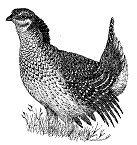Papers in the Biological Sciences

Papers in Ornithology
Document Type
Article
Date of this Version
1961
Abstract
A comparative morphological, behavioral, and electrophoretic study was undertaken on six populations of North American mallards that are currently considered by the A.O.U. Check-list to comprise four species and two additional subspecies. These include Anas p. platyrhynchos, A. d. diaxi, A. d. novimexicana, A. f. fulvigula, A. f. maculosa, and A. rubripes. These forms are essentially allopatric in their breeding distributions, with the major exception of A. p. platyrhynchos and A. rubripes, which overlap throughout a several-hundred-mile zone in east-central United States.
Geographic ranges and population sizes are estimated, and evidence is presented to indicate that the present sympatry of rubripes and platyrhynchos is of recent origin and is rapidly increasing. Plumage differences in the populations were investigated by the "Hybrid index" method, and it was concluded that, except for the sexual dimorphism of platyrhynchos, only minor quantitative differences in feather patterns differentiate the populations. Evidence from experimental hybridization was presented to show that the genetic basis for the sexual dimorphism of platyrhynchos is relatively simple, and should not be considered an importantt axonomic criterion. Analysis of the sexual behavior of male platyrhynchos and rubripes failed to reveal any important differences other than slight differences in male response thresholds. Electrophoretic studies of the egg-white proteins of platyrhynchos, rubripes, and fulvigula likewise failed to show any noticeable differences in the proportions and electrophoretic characteristics of these proteins.
A discussion of ecological, geographic, and behavioral isolating mechanisms of the populations, and the incidence of hybridization where they overlap resulted in the conclusion that none of the forms could reasonably be considered specifically distinct from any or all of the others. It is recommended that diazi, fulvigula, and maculosa be considered geographic races of Anas platyrhynchos, and that novimexicana be considered a synonym of diazi. It is also concluded that rubripes cannot satisfactorily be considered a distinct species and that increasing hybridization indicates that it might eventually be necessary to consider it a subspecies of Anas platyrhynchos.


Comments
Published in the Auk (January-March 1961) 78(1): 3-43. Copyright 1961, the University of California. http://elibrary.unm.edu/sora Used by permission.